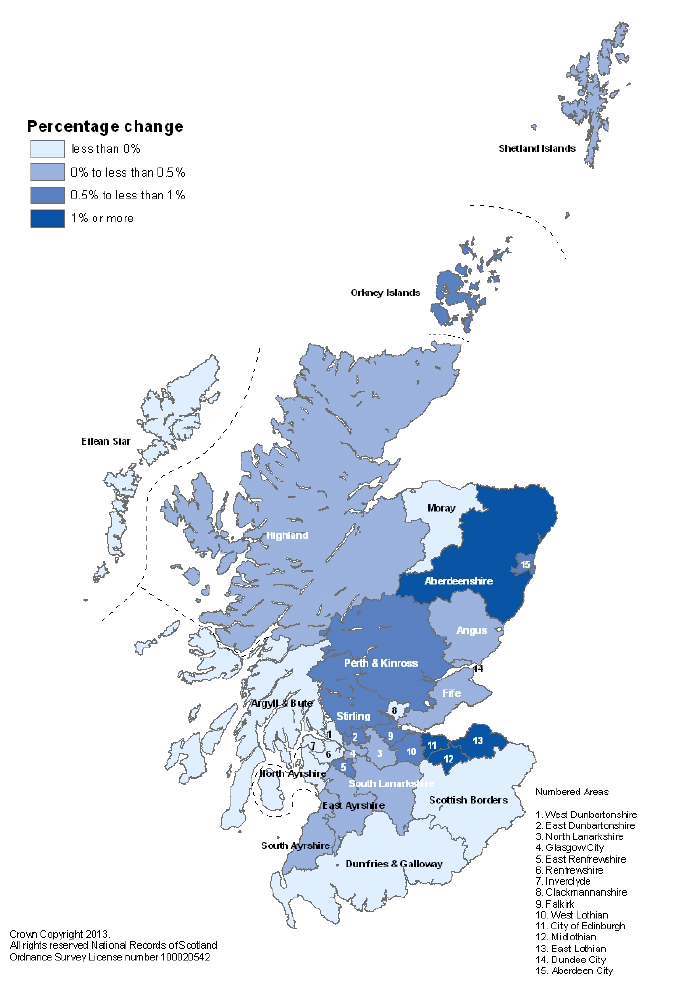
4.1 The relative importance of migration and natural change differs between Council areas. In some areas that have had a population increase, such as Midlothian, City of Edinburgh and Aberdeenshire, the gain is attributable both to migration and natural increase (more births than deaths). East Lothian, Stirling and Orkney Islands experienced a population increase because of in-migration combined with a very low natural change. In other areas, the population increase is due to in-migration, despite the number of deaths exceeding the number of births. These included Perth & Kinross and South Ayrshire.
4.2 Similarly, some areas of population decline, such as Argyll & Bute, Inverclyde and Moray have experienced population decreases both from migration and natural change. In other areas such as Eilean Siar, Dumfries & Galloway and Scottish Borders, the population decline was mainly attributable to more deaths than births. This analysis is shown in Table A, which compares percentage change in population due to natural change and migration across the Council areas.
Table A: Components of population change for Council areas: Census Day 2011 to mid-2012
| Natural change1 | Net civilian migration and other changes1 | Percentage population change2 | |
| Scotland | 0.1 | 0.2 | 0.3 |
| Council areas | |||
| Argyll & Bute | -0.4 | -1.8 | -2.2 |
| Inverclyde | -0.3 | -0.6 | -1.0 |
| Moray | -0.1 | -0.4 | -0.6 |
| Eilean Siar | -0.6 | 0.2 | -0.4 |
| North Ayrshire | -0.1 | -0.3 | -0.4 |
| West Dunbartonshire | 0.0 | -0.4 | -0.4 |
| Renfrewshire | 0.0 | -0.3 | -0.3 |
| Clackmannanshire | 0.3 | -0.6 | -0.3 |
| Dumfries & Galloway | -0.3 | 0.0 | -0.3 |
| Scottish Borders | -0.1 | 0.1 | -0.1 |
| Angus | -0.1 | 0.2 | 0.0 |
| East Ayrshire | 0.1 | -0.1 | 0.0 |
| North Lanarkshire | 0.2 | -0.2 | 0.1 |
| South Ayrshire | -0.4 | 0.5 | 0.2 |
| South Lanarkshire | 0.1 | 0.1 | 0.2 |
| Shetland Islands | 0.3 | 0.0 | 0.2 |
| Fife | 0.1 | 0.2 | 0.3 |
| Highland | 0.0 | 0.3 | 0.3 |
| Glasgow City | 0.3 | 0.1 | 0.3 |
| Dundee City | 0.1 | 0.3 | 0.4 |
| East Renfrewshire | 0.1 | 0.5 | 0.5 |
| West Lothian | 0.5 | 0.1 | 0.6 |
| Falkirk | 0.2 | 0.3 | 0.6 |
| Perth & Kinross | -0.1 | 0.9 | 0.8 |
| East Dunbartonshire | 0.0 | 0.9 | 0.8 |
| Orkney Islands | 0.1 | 0.8 | 0.9 |
| Stirling | 0.0 | 0.9 | 0.9 |
| Aberdeen City | 0.4 | 0.6 | 1.0 |
| Aberdeenshire | 0.3 | 0.7 | 1.1 |
| Edinburgh, City of | 0.3 | 0.8 | 1.2 |
| East Lothian | 0.2 | 0.9 | 1.2 |
| Midlothian | 0.4 | 0.8 | 1.2 |
Footnotes
1) Change per 100 population at mid-2012. The underlying data used to produce these figures can be found in Table 4a of this publication.
2) Ordered by percentage population change.
3) Due to rounding, the percentage population change may not match that shown in the map at Figure 7.
Figure 7: Percentage population change between Census Day 2011 and mid-2012
